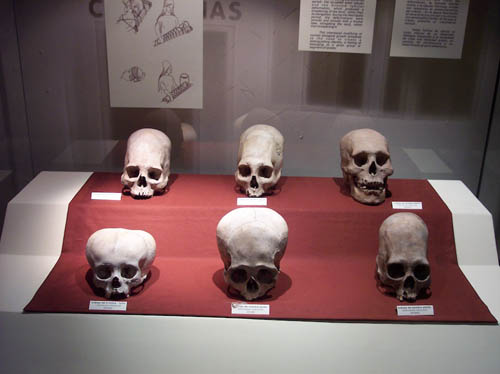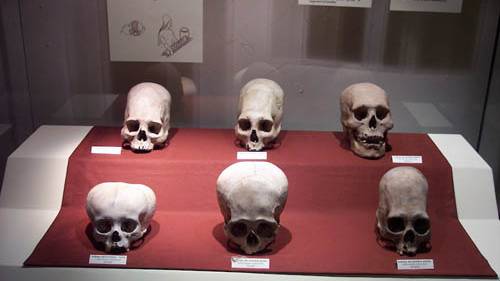A Look at Theories About Elongated Skulls in Ancient Peru, Europe, Egypt
Source: theepochtimes.com
Elongated skulls have been found in ancient burial grounds around the world. Many are the result of a practice of intentionally deforming the skull with binding applied during the early years of a child’s life. Some may be explained by natural deformity. Yet enough mystery is left in relation to some of the skulls for various theories to arise.Could the elongated skulls in Paracas, Peru, for example, come from a human-like species never before studied?
Paracas, Peru

A case of skulls from the Andean Paracas culture, as seen in the National Museum of the Archaeology, Anthropology, and History of Peru. (Wikimedia Commons)
Some of the most famous elongated skulls are those found in Paracas on the coast of Peru. The skulls are believed to be from 3,000 to 2,000 years old.
Brien Foerster, assistant director of the Paracas History Museum in Paracas, announced in February that a geneticist analyzed the first flesh sample from the skulls and found that segments of its DNA do not match any known human or human-like species from the past.
The results are preliminary, and Foerster said he made the announcement to gain public interest, and thus funding to continue analysis on more samples.
Though Foerster did not name the geneticist, he said this geneticist is in the United States, has all the right credentials, and does contract work for the American government.
Foerester has taken a keen interest in elongated skulls and done much independent research over the years. He told Ancient Origins in a taped interview (see below) in February that about 5 to 10 percent of the hundreds of elongated skulls he has seen from around the world do not appear to be the result of intentional deformation. The binding techniques usually leave a flattened surface on part of the skull, but some of the skulls he has seen appear quite natural.
Foerster’s credibility has been questioned by some. He does not appear to have an advanced degree or formal archaeological training. Though he is the assistant director of the Paracas History Museum, this is a privately owned museum, and some point out that it stands to gain from the publicity.
Epoch Times will be waiting to hear more, and perhaps further DNA testing and public testimonial from geneticists will shed more light on the matter.
Egypt’s Pharaoh Akhenaten

The Wilbour Plaque, ca. 1352–1336 B.C., depicts Akhenaten and Nefertiti late in their reign. (Wikimedia Commons)
The skull of one of ancient Egypt’s most mysterious kings, Akhenaten, is depicted as elongated. This is anomalous, not customary.
The University of Maryland School of Medicine co-sponsored a conference in 2008 specifically aimed at exploring theories about Akhenaten’s physiology.
A university news release from the time sums up some of the questions asked: “Were his artisans following his orders to employ an artistic style for some religious purpose? Or did he really look this bizarre, and if so, why?”
[...]
Read the full article at: theepochtimes.com
Tune into Red Ice Radio:
Brien Foerster & L.A. Marzulli - Hour 1 - Paracas Elongated Skull DNA Analysis & The Nephilim Connection
Ross Hamilton, Jim Vieira & Hugh Newman - Hour 1 - Giants, Mound Builders & Etheric Energy
Lloyd Pye - The Annunaki & Genetic Engineering
Lloyd Pye - Extraction of Nuclear DNA from the Starchild Skull
Lloyd Pye, Brien Foerster & Jerry Wills - Hour 1 & 2 - Human Origins & Lost Races
Troy McLachlan & Theodore Holden - Hour 1 - Cosmos in Collision: Antique Solar System, Neanderthals & Modern Man






















